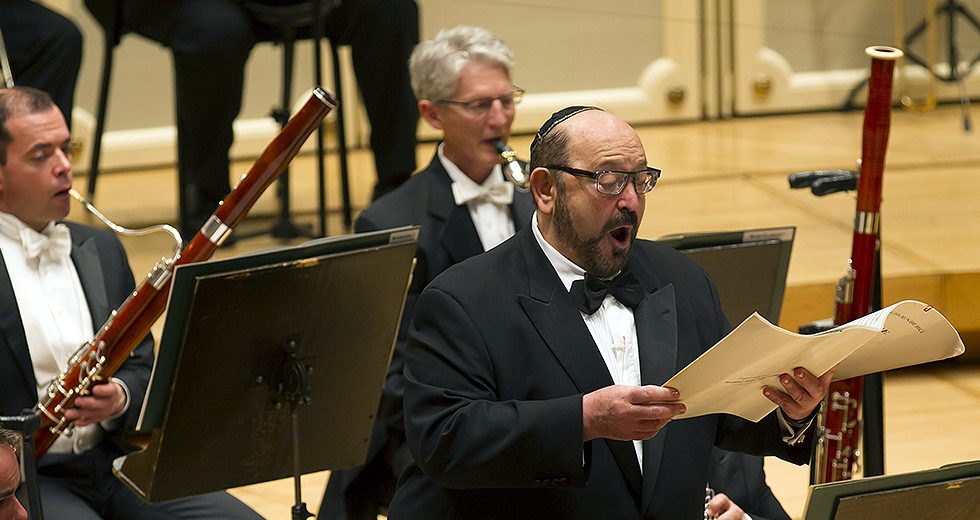
By any measure, Greek-born tenor Alberto Mizrahi has a stellar musical career.
Cantor for 25 years at Anshe Emet Synagogue, a historic Conservative congregation in Chicago’s Lake View neighborhood, he has sung at the White House for President George W. Bush and at the U.S. Capitol for an audience that included President Obama. Mizrahi, an internationally known interpreter of Jewish music, is featured on several discs issued in the Milken Archive’s authoritative 50-CD survey of the world of Jewish music. As a young man pursuing an opera career, he participated in the first Pavarotti International Voice Competition in 1981 and later served as the legendary tenor’s understudy in performances of Verdi’s Un Ballo in Maschera at Miami Opera (now known as Florida Grand Opera).
In March 2000, Mizrahi appeared with the Chicago Symphony Orchestra as a narrator in Seven Gates of Jerusalem, a massive choral-symphonic piece by Polish composer Krzysztof Penderecki, conducted by the composer at Symphony Center.
But, according to Mizrahi, working four years ago with CSO Music Director Riccardo Muti on Arnold Schoenberg’s setting of the traditional Jewish text Kol Nidre was perhaps the highest point of his already distinguished career. A recording drawn from those Symphony Center performances in March 2012 will be released Sept. 30 in the United States (Oct. 7 worldwide) on the CSO Resound label. The disc also features Shostakovich’s Suite on Verses of Michelangelo Buonarroti with Russian bass Ildar Abdrazakov as soloist.
“To tell you the truth, I had never heard the piece before,” said Mizrahi of Schoenberg’s 1938 setting of Kol Nidre, arranged for chorus, orchestra and narrator. “I looked it up and I found only one recording, with Pierre Boulez and George Shirley-Quirk [a Sony disc recorded in 1984 with the BBC Symphony and BBC Chorus].
“It was very British,” said Mizrahi, his lively, genial speaking voice dropping into the slower, considered cadences of a Shakespearean thespian. “I said, ‘OK, that sounds good to me,’ and I practiced it that way.” After working with CSO Chorus Director Duain Wolfe, Mizrahi had a private coaching session with Maestro Muti at Symphony Center.
“First, Pierre Boulez walks into the room,” Mizrahi recalled with a laugh. “He happened to be in town, and he heard that we were doing the piece, so he wanted to hear the rehearsal.”
Once Maestro Muti arrived, said Mizrahi, “I started doing it the way I had heard it. He said, ‘That’s very nice. Now let’s try this.’ We were there maybe 30, 40 minutes. In those 40 minutes, I felt like I got a semester’s worth of coaching. He enlightened me and made me feel like it was my idea to do it this [other] way.”
Schoenberg was living in Los Angeles in 1938, having fled his native Austria following the rise of the Nazis. Jacob Sonderling, the rabbi of the city’s leading liberal Jewish congregation, asked Schoenberg to compose new music for Kol Nidre for that year’s High Holidays. Stretching over eight days every autumn, the holidays mark the start of the Jewish New Year. Kol Nidre is chanted at the start of services on Yom Kippur, the Day of Atonement, the most solemn, and final, day of the High Holidays.
Running approximately 15 minutes, Schoenberg’s version opens with brooding instrumental music that shifts between orchestral rustles and darting solo passages before the narrator enters with a spoken text written by Sonderling. The traditional Kol Nidre text that follows is split between chorus and narrator with the orchestra continuing to add its own, atmospheric voice.
“The music is very beautiful. It’s not late Schoenberg,” said Mizrahi, referring to Schoenberg’s experiments with non-tonal melodies and harmony. But modernist clashes and clangs punctuate its unsettled but essentially lyrical flow. The traditional Kol Nidre chant melody, a mournful tune that Mizrahi describes as “ingrained in the Jewish soul,” is all but invisible, appearing only as a fragment buried in the orchestral texture midway through the piece.
Muti, one of the world’s great opera conductors and universally acknowledged as the pre-eminent Verdi conductor of his generation, urged Mizrahi to heighten the drama, to make the narrator the prime mover of the piece.
“The best thing Maestro Muti told me,” said Mizrahi, “was this: In most pieces, the soloists (or narrator) follow the orchestra. The conductor has an idea of how the music will be played, and the narrator comes in with that mood and speaks it. In this piece, Maestro Muti said, the orchestra does what the narrator sets up. He insisted that I do this very dramatic stuff.”
Listening to the recording, Mizrahi said, he worried at first that he sounded too far over the top. “But when you listen to it as a whole, it makes a lot of sense.”
“It’s one of the greatest privileges of my life,” Mizrahi said, “to be on a CD with the name Muti. And the CSO? It’s really a highlight of my life.”
Wynne Delacoma, classical music critic of the Chicago Sun-Times from 1991 t0 2006, is a Chicago-based arts journalist.
TOP: Alberto Mizrahi performs Schoenberg’s Kol Nidre with the Chicago Symphony Orchestra in March 2012. The program was recorded and is featured on a CSO Resound release out Sept. 30. | Todd Rosenberg Photography 20212